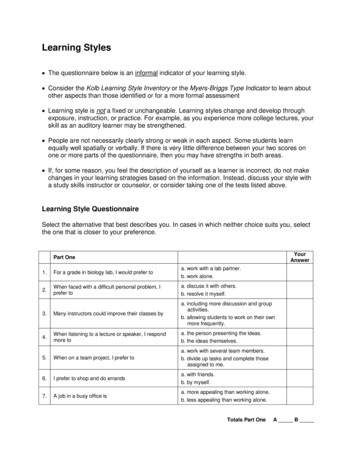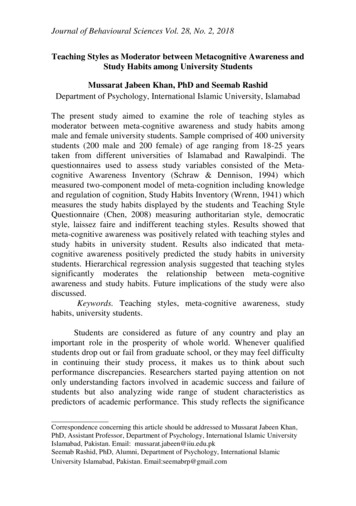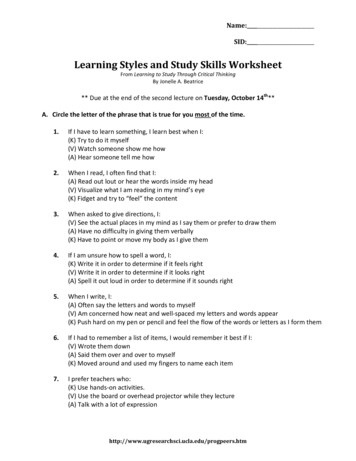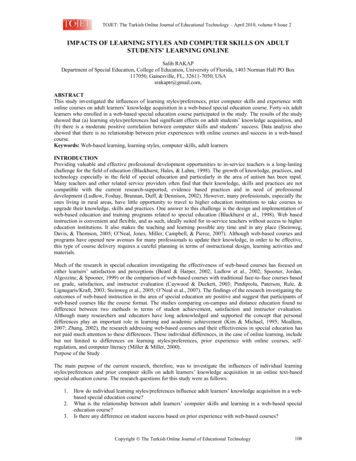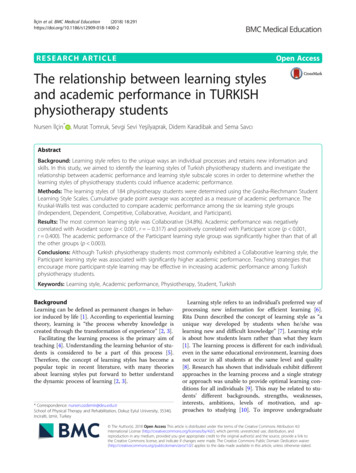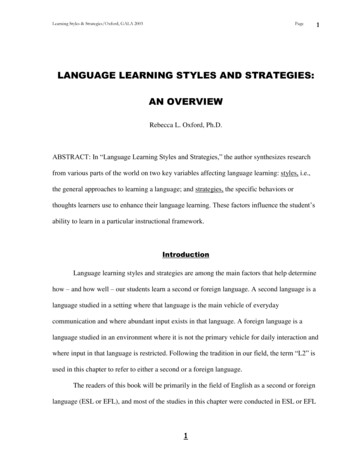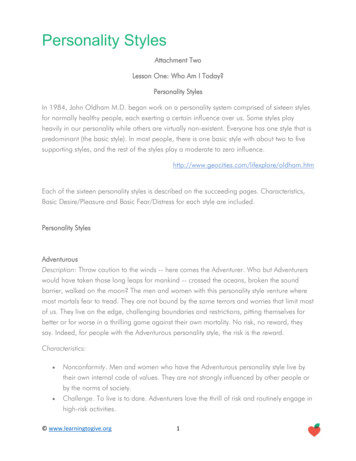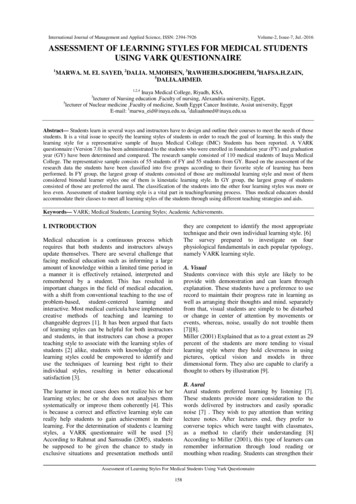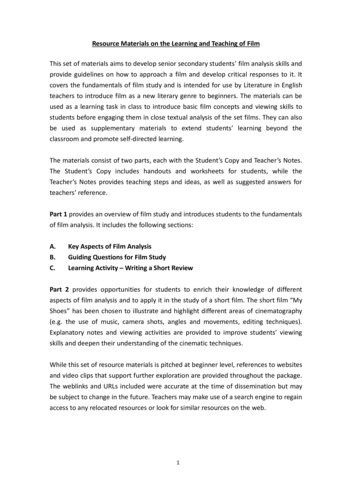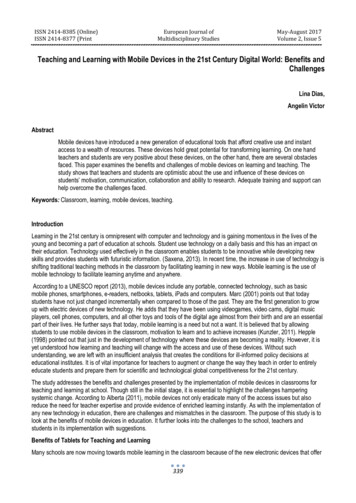
Transcription
International Journal of Evaluation and Research in Education (IJERE)Vol. 8, No. 3, September 2019, pp. 610 615ISSN: 2252-8822, DOI: 10.11591/ijere.v8i3. 20345 610Learning styles and teaching styles determine students’academic performancesNithya Dewi Subramaniam Chetty1, Lina Handayani2, Noor Azida Sahabudin3, Zuraina Ali4,Norhasyimah Hamzah5, Nur Shamsiah Abdul Rahman6, Shahreen Kasim71,3,6Facultyof Computing, Universiti Malaysia Pahang, Malaysiaof Public Health, Universitas Ahmad Dahlan, Indonesia4Department of English, Centre for Modern Languages & Human Sciences, Universiti Malaysia Pahang, Malaysia5Faculty of Technical and Vocational Education, Universiti Tun Hussein Onn Malaysia, Malaysia7Faculty of Computer Science & Information Technology, Universiti Tun Hussein Onn Malaysia, Malaysia2FacultyArticle InfoABSTRACTArticle history:Individuals learn in different ways using several learning styles, but lecturersmay not always share material and learning experiences that match students’learning preferences. Mismatches between learning and teaching styles canlead to disappointment with students are taking, and lead tounderperformance among them. The aim of this study is to identify thelearning styles of the students enrolled in Universiti Malaysia Pahang whowere registered in Programming Technique course and to investigate therelationship between students’ learning styles and teachers’ teaching styles.Five lecturers and 251 students were involved in the study as participantsand. Data from students were collected using Leonard, Enid’s VAK LearningStyle Survey. Meanwhile, the teaching styles of the lecturers were identifiedusing Grasha and Reichmann’s Teaching Style Survey. The findings revealedthat majority of the student’s preferred visual learning style. The result alsoshows that the lecturers’ teaching styles give an impact towards thestudents’ academic performance. From this study, we can conclude thatteaching styles have significant impacts on students’ learning styles andacademic performances.Received Oct 2, 2019Revised Nov 13 , 2019Accepted Nov 30, 2019Keywords:Academic performanceLearning style preferenceStudentsTeaching style preferenceCopyright 2019 Institute of Advanced Engineering and Science.All rights reserved.Corresponding Author:Noor Azida Sahabudin,Faculty of Computing,Universiti Malaysia Pahang,26600 Pekan, Pahang, Malaysia.Email: azida@ump.edu.my1.INTRODUCTIONTeaching and learning styles play a crucial role in this academic world. Diverse styles of teachingand learning occur due to the reaction among students in relation to the teaching styles that are demonstratedby the lecturers. This chain-reaction affects the students’ learning styles preferences [1]. In addition, thediversity in teaching and learning styles preferences would result in matches and mismatches between thelecturers’ teaching styles and students’ learning styles.According [2] learning style refers to students’ preferred learning approaches for all learningsituations while teaching styles refer to the lecturers’ behavior, beliefs and selected instructional methodsused to present lessons to students [2, 3, 24]. Currently, they are many research that are conducted on theconcepts of students’ learning style and educators’ teaching style [4, 5].In addition, students’ learning styles reflect genetic coding, personality development, andenvironmental adaptations [6]. Research shows that students gain more knowledge, retain more informationand perform better when the teachers’ learning styles match with the students’ learning styles [7]. However,Journal homepage: http://iaescore.com/journals/index.php/IJERE
Int J Eval & Res Educ.ISSN: 2252-8822 611According to Gilakjani, one of the weaknesses of the research in learning style is the lack of investigationconcerning the matching of teaching and learning styles [8]. Due to this gap, the current study, therefore,aims at matching the students’ learning styles and the lecturers’ teaching styles. In other words, this studyis conducted with the objective to examine the relationship between students’ learning styles andlecturers’ teaching styles. Also, the research evaluates the impact of teaching style toward students'academic performances.2.LITERATURE REVIEWIn general psychology, the term learning styles refers to learners’ favoured approach to learning,which includes the process of receiving, collecting, processing, and interpreting to become knowledgeable [9,10, 25]. A general principle, educational and management approaches are considered as teaching style for aclassroom instruction - how an educator imparts knowledge to their students [11].Some researchers suggest that learning styles and teaching styles should be well matched in order toenhance students’ motivation of learning [12, 13, 26]. Research done by [14] found that there was a positiverelationship between self-efficacy and teachers teaching thinking practices whereas there was a negativerelationship between personal model teaching style and teaching thinking skills. A different study conductedby [15] on the analysis of learning styles prevalent among secondary school students also tried to find therelationship and effect of different learning styles on academic achievements of students. Findings of thestudy revealed that, kinesthetic learning style was more prevalent than visual and auditory learning stylesamong secondary school students. Angela investigated a match or mismatch between learning and teachingstyles in Science education among 179 students and 50 lecturers from Faculty of Science, Sana’a University,Yemen. According to the results, it showed that kinesthetic learning mode preference was reported as themajor learning style among the students while visual and auditory learning style were as the minor learningstyles demonstrated by them. Thus, the findings revealed that there is a mismatch between the learning styleand teaching styles [16].Meanwhile, a study conducted by [17] was find out the impact of teaching and learning stylepreferences and their match/mismatch on learners’ achievement among 310 English Major Students and four(4) lecturers from the Foreign Languages Faculty of Azad University, Iran. The results of the study revealedthat matching teaching and learning styles in EFL classes helped to improve students’ achievement [17].A study conducted by [18] was examine the effect of the match between the Learning and TeachingStyles of Teachers on Students’ Achievement among 700 students and 31 teachers. The results of this studyrevealed that teachers created the learning surroundings depending on their own learning styles and that therehas been a close relationship between teachers’ learning styles, students’ learning styles and students’achievements in mathematics classes, that students’ achievements increased when teaching is done based ontheir learning styles. Besides that, the study revealed that there was a significant relationship betweenteachers’ teaching style and students’ learning style and students’ academic achievements if they match withone another learning style [18]. The result obtained with this study has parallelism with those of some otherstudies in the literature [19-21].Having to discuss studies concerning learning styles and teaching styles, it is evident that the issueof matching teaching styles and learning styles is controversial and the topic needs for more thoroughresearch. It can be concluded that an effective teacher needs to have a resource bank of different teachingmethods and activities to draw on from time to time so that maximum can be facilitated [22].3.METHODThe quantitative research approach includes the collection and analysis of numerical data to describeand generalize conditions, investigate relationships, and study the cause-effect of phenomena. The sample forthis study was 251 undergraduates’ students from Faculty of Computing, UMP who have taken theProgramming Techniques subject and five lecturers.To investigate the learning styles of the students, questionnaires were distributed to the students viaonline (Google Forms). The questionnaire was constructed based on VAK Learning Styles Questionnaire(LSQ); adopted from Leonard, Enid. College Success Simplified, 2005. It consists of three styles assessed by30 items, 10 items for each style. Each item requires the student to answer Yes or No. The highest scoreindicates the students’ preference. The lowest score indicates weakest modality. If all three scoresare identical, the students have truly integrated all three modalities and can work equally well in any ofthe modalities.The Teaching Style Survey (TSS) by Grasha-Riechmann is an instruments that was employed in thisstudy. TSS questionnaire contains 40 questions in five sections that include the questions of Expert methodLearning styles and teaching styles determine students’ academic (Nithya Dewi Subramaniam Chetty)
612 ISSN: 2252-8822(8 items), Formal authority (8 items), Personal model (8 items), Facilitator (8 items) and Delegator (8 items).Likert scales statements are used to range students’ preferences of an item in the questionnaire in that thescales range from completely agree to completely disagree. The questions have ranked from 1 (extremelydisagree) to 5 (extremely agree). The total score of each segment was partitioned to 8 as per the questionnaireindex in each teaching method.The main data sources of the proposed study are from questionnaire results and from students’academic performance. The questionnaire data was analyzed quantitatively. Statistical Package for the SocialSciences (SPSS) Version 17.0 was used to analyze students’ responses towards the learning style preferencesquestionnaire and teachers’ responses towards the teaching style preference questionnaire. In this study, thereare two type of datum which are called nominal data and ordinal data. A profile of results was established foreach participant. The frequency distribution of questionnaire results was examined. The means for each itemwere calculated and items with higher use were identified. The standard of p .05 was used to determine thestatistical significance of results.4.RESULT AND DISCUSSIONThe respondents were asked to answer the questions listed in VAK LSQ. The three (3) learning styleswere tested in VAK LSQ include: Visual (V), Auditory (A) and Kinaesthetic (K). Highest score in a givendimension would mean that the student prefers that particular learning style. Further, in this study, thestudents‘learning style preferences reported include: unimodal (one strong dimension), bimodal (two strongdimensions) and trimodal/multimodal (three strong dimensions).The Figure 1 shows that the most preferred learning style by the students is the unimodal dimensionwith 49.8% which involve only the visual style. In other words, majority of the students have strong visualmodality. The Visual learning style is followed by the Kinaesthetic Style (unimodal) with 40 (15.94%) of therespondents and on third position is the bimodal dimension Visual and Kinaesthetic (V/K) with 11.95% ofthe respondents reporting their preference on it. The least preferred learning style dimensions are the trimodalVAK dimension and bimodal Auditory/Kinesthetic (A/K) dimension which had 3.98% and 4.38% preferencelevels respectively.Figure 1. Students’ learning style preferenceTable 1 shows that the most preferred teaching style by the lecturer is the Facilitator which involveguides and directs students by asking questions, exploring options, suggesting alternatives, and encouragingthem to develop criteria to make informed choices. The rest demonstrated Delegator, Formal Authority andPersonal Model teaching styles where 20% each style.Table 1. Lecturers’ teaching style preferencesTeaching styleExpertFormal AuthorityPersonal %20%20%40%20%Int. J. Eval. & Res. Educ. Vol. 8, No. 3, September 2019: 610 - 615
Int J Eval & Res Educ.ISSN: 2252-8822 613To identify students learning styles and lecturers’ teaching styles, descriptive analysis technique wasused. The teaching style i.e. Grasha-Riechmann Teaching Style Inventory was employed to ProgrammingTechnique lecturers. Each section was conducted by 1 lecturer. Section means class that is conducted by thelecturers. Table 2 reveals the teaching style of the lecturer according to the section they are teaching.Lecturers section 2 and 3 shares same technique of teaching style whereas the rest are different.Table 2. Lecturers’ teaching style according to the sectionSection12345Teaching styleFormal AuthorityFacilitatorFacilitatorDelegatorPersonal ModelThe Figure 2 describes the learning styles of students who involve in this study acording to theirclass section. Visual style is the most preferred learning style in every sections. Section 2 has the highernumber of students compare to other sections.Figure 2. Number of students in each sectionTo evaluate the impact of teaching style and learning style towards students’ academic performance,Table 3 shows final status of students in Programming Technique, whether they manage to pass or fail intheir final exam. Unimodal learners and multimodal learners have positive and strong relationship on everyteaching style. This would be considered as a matched teaching and learning styles. On the other hand,bimodal learning styles mismatched with certain teaching style. There is a mismatch between facilitatorteaching style and visual and kinaesthetic style (V/K), visual and auditory style (V/A) and auditory andkinaesthetic style (A/K) learning styles. 55% of bimodal learners are not doing well in this class. Besidesthat, personal model and formal authority teaching style are matching with all the learning styles exceptvisual and auditory style (V/A) learning style. Majority of the visual and auditory style (V/A) learners in thisclasses are not doing well in their exam. So, there was mismatch between visual and auditory style (V/A) andFormal Authority and Personal Model teaching style. When examined the Delegator teaching style, therelationships for the bimodal learning styles was moderate level. For instance, the relationship between theVisual and Kinaesthetic Style (V/K) learning style and Delegator teaching style was balance and relationshipbetween auditory and kinaesthetic style (A/K) learning style was negative. Table 4 shows the summary of theresult from the Table 3.The results show that there is an impact on academic performance among students and lecturers ifthere is a mismatch occurred between the learning style and teaching style [24]. It was observed that most ofthe lecturers did not use a multiple of teaching method to match the learning style preference of each student.Instead, most of them employed only a single style of teaching. As a result, there was a mismatch betweenthe students’ learning style preferences and the teachers' instructional approach which may highly influencestudents’ attitudes and motivation. For future research it is recommended that the researchers use a hugeLearning styles and teaching styles determine students’ academic (Nithya Dewi Subramaniam Chetty)
614 ISSN: 2252-8822sample in order to obtain more reliable, informative and better results. This is because present study wasrestricted to only Programming technique students and lecturers which did not involve all other subjectlecturers and students. The researcher agrees with Peacocks’ suggestions that the lecturers and teachingmaterials and syllabuses always have to include assortment of learning and teaching styles [23].Table 3. Student’s academic performance verses lecturers’ teaching hipVS85PositiveTeaching style: Teaching style: Personal ativeTeaching style: PositiveTeaching style: Formal /K50NegativeVAK10PositiveTable 4. Relationship between Teaching style and Learning styleLearning StyleVisual Style (VS)Auditory Style (AS)Kinaesthetic Style (KS)Visual and Kinaesthetic Style(V/K)Visual and Auditory Style (V/A)Auditory and Kinaesthetic Style (A/K)Visual, Auditory and Kinaesthetic Style (VAK)Relationship – Teaching styleMatch – allMatch – allMatch – allMatch - Personal Model and Formal AuthorityMismatch – FacilitatorBalance - DelegatorMatch – DelegatorMismatch – Facilitator, Personal Model and Formal AuthorityMatch – Personal Model and Formal AuthorityMismatch – Facilitator and DelegatorMatch – all5.CONCLUSIONBased on the analysis, the study showed that most respondents i.e. students, preferred and mainlydemonstrated visual learning styles, followed by Kinaesthetic style (KS), Visual and Kinaesthetic style(VK),Visual and Auditory style (VA), Auditory and Kinaesthetic style (AK), Visual Auditory and Kinaestheticstyle (VAK) and Auditory style(AS). Students with visual and kinaesthetic learning styles show goodachievement, while some student with bimodal learning styles do not achieve good results. The study found asignificant relationship between learning styles and teaching styles because it can increase or decreasestudents’ academic performances. Therefore, lecturers need to prepare a few types of material on a sametopic and conduct their classes in various ways to ensure that they may assist student to understand what thelecturers are trying to deliver in their learning way.ACKNOWLEDGEMENTSThis research is supported by UMP Research Grant Scheme, RDU1703270. The authors fullyacknowledged Universiti Malaysia Pahang (UMP) for the approved fund which makes this importantresearch viable and effective.REFERENCES[1]D. M. Jepsen, M. M. Varhegyi, and S. T. T. Teo, "The association between learning styles and perception ofteaching quality," Educ. and Train., vol. 57(5), pp. 575-587, Jul 2015.Int. J. Eval. & Res. Educ. Vol. 8, No. 3, September 2019: 610 - 615
Int J Eval & Res N: 2252-8822 615L. Mei Ph’ng, "Teaching Styles, Learning Styles and the ESP Classroom," MATEC Web Conf., vol. 150,pp. 5082, 2018.L. M. Ph’ng, T. S. Ming, and R. M. K. Nambiar, "Match or mismatch: Teaching styles and learning styles in anESP classroom," Soc. Sci., vol. 11(12), pp. 2977-2982, 2016.J. Cuevas, "Is learning styles-based instruction effective? A comprehensive analysis of recent research on learningstyles," Theory Res. Educ., vol. 13, 2015.Y. Li, J. Medwell, D. Wray, L. Wang, and L. Xiaojing, "Learning styles: A review of validity and usefulness," J.Educ. Train. Stud., vol. 4(10), pp. 90-94, 2016.C. S. Guy and S. Denson-Guy, "An Introduction to Learning and Teaching Styles: Making the Match," Fisheries,vol. 20:2(2), pp. 18-20, Feb 2011.S. A. Husin, "Matching teaching styles with students’learning styles (A survey of Indonesian students’habits oflearning)," Let Linguist. Lit. English Teach. J., vol. 6(2), 2017.A. P. Gilakjani, "A match or mismatch between learning styles of the learners and teaching styles of the teachers,"Int. J. Mod. Educ. Comput. Sci., vol. 4, pp. 51, 2013.D. A. Kolb, "Experiential learning: Experience as the source of learning and development," FT press, 2014.W. L. H. Wong, "A study of language learning style and teaching style preferences of Hong Kong communitycollege students and teachers in English for Academic Purposes (EAP) Contexts," 2015.M. Alami and P. Ivaturi, "Typical teaching styles among ELC Lecturers at Salalah College of technology," Oman,vol. 3, 2016.B. J. Ghaedi, Zahra, "Relationship between learning styles and motivation for higher education in EFL
Learning styles and teaching styles determine students’ academic (Nithya Dewi Subramaniam Chetty) 613 To identify students learning styles and lecturers’ teaching styles, descriptive analysis technique was used. The teaching style i.e. Grasha-Riechmann Teaching Style I
